Early summer salmon fisheries get underway June 1 in freshwater and marine areas 2
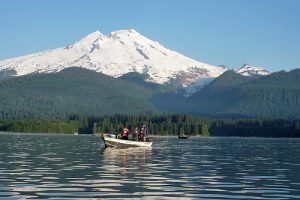
Early summer sockeye fishing on Baker Lake is a big draw. A section of Lower Skagit River opens June 16 for sockeye followed by Baker Lake on July 7.
All eyes are on early returning salmon runs including sockeye – one of the first summer migrating salmon species – and chinook making the journey from the ocean back to natal streams and lakes.
Anglers have already started prepping their fishing gear to hit the Skagit River and Baker Lake where 35,002 sockeye are forecast to return, which is somewhat down from 47,000 last year (33,359 was the actual return) and 55,054 in 2016.
“This summer’s sockeye return is relative to historic runs, and it is still a big number,” said Brett Barkdull, a WDFW biologist. “We’re predicting survival rates are going to be down a fair amount based on unfavorable ocean conditions. The first year we had a big return was in 2010 and so this summer’s run falls right in the middle. We’ve had returns between 17,800 and a high of 51,000.”
On the leading edge of that sockeye run is a Skagit/Cascade spring chinook forecast of 5,756 where 270 adult fish have already returned to the Marblemount Hatchery through May 24.
“I’m not worried about making escapement for spring chinook,” Barkdull said. “If you look at forecasts it is a little on the large size in relative years and not as big as the actual return last year of 5,000. The handful of guys I talked to last year who fished it did super well and it doesn’t get the participation but there is fish to catch for sure.”
Spring chinook prefer higher water and rather dirty conditions like what we’re experiencing right now due to a lot of glacial runoff coming down from the mountains and hillsides in the northern Cascades.
The Skagit from the Highway 530 Bridge at Rockport to Cascade River Road and from Cascade mouth to Rockport-Cascade Road Bridge opens June 1 through July 15 for hatchery-marked chinook.
The first sockeye opportunities will begin on the Skagit River from Memorial Highway Bridge to Gilligan Creek, which opens June 16 through July 15.
In past sockeye seasons when high water flow was prevalent the sockeye fishery seemed to be more productive, and much slower when flows and water levels were low.
That river fishery will be followed by Baker Lake opening July 7 through Sept. 7 with the typical peak timing occurring in late-July and early-August. Much of this is dictated by the numbers of fish at the fish-trap on the river and timing of trucking fish up into the lake.
Brett Barkdull, a Washington Department of Fish and Wildlife (WDFW) biologist points out that trying to get a grip on the eventual outcome of the sockeye run is all over the map and like “throwing a dart into the middle of a dart board.”
In general, the two- and three-year-old sockeye returnees this summer are coming off a very solid juvenile outmigration but survival in the ocean wasn’t ideal. This summer WDFW is predicting a survival rate far less than 5 percent to return even though the three-year-old age class fish are coming off a million outgoing juvenile smolts.
“These low numbers are a little disappointment because we’ve got the big number of outgoing smolts,” Barkdull said. “We’ve got a lot of fish going out in general so when you start having between 700,000 and 1.1-million smolts all you need is a better than normal survival and someday we’ll have a 100,000 fish return year. That’s just a matter of having ideal ocean conditions and a high survival rate.”
From a run timing standpoint it is likely that there should be sockeye already in the river when it opens. Arrival time varies year-to-year, but the best two weeks of fishing should be last week of June and first week of July when a lot of fish are passing through, which is based on a normal run curve.
“The higher the water levels the better for sockeye, and if the river is puking mud that pushes the fish right onto the banks and limits the travel lanes and gets them easily targeted,” Barkdull said. “You only need to cast about five feet from the shoreline and I’ve seen guys casting way beyond the banks with not much luck. If the water level is low then the sockeye are often scattered across the river.”
Barkdull says the early portion of the sockeye run tends to bite really well, and when the fishery first opens catch rates are pretty good even given the fact that there aren’t many fish yet in the river.
The key to tracking when the best fishing occurs in the lake is to follow the fish trucking on WDFW website at http://wdfw.wa.gov/fishing/salmon/sockeye/baker_river.html.
“Things have changed up at Baker Lake and what used to happen is everyone would fish at Noisy Creek and now folks have discovered is you can catch fish down by the dam,” Barkdull said. “Last year we had a lot of effort and the inconsistency on the fishery has been more driven by when the fish were put in the lake. People started to figure out a new pattern and in terms of the catch rate the fish got caught in fairly good numbers.”
Like any fishery moving around will be a key to success so if you don’t mark mch fish on the fish-finder then head to another location.
Baker sockeye were first introduced from an artificial enhancement that started in 1896 when the state built a hatchery on Baker Lake. The natural run at that time was estimated to be approximately 20,000 fish, which was way before the dams were built.
Success of sockeye returns is based on improved juvenile fish production. Puget Sound Energy work crews have a huge fish barge collector anchored above Lower Baker Dam on Lake Shannon. The collector draws migrating juvenile salmon unto a funnel where they’re held until being transferred below the two dams and released to begin their outmigration.
Since the 1920s, annual adult sockeye returns averaged 3,500, and then by the early 1980s it dropped off the charts and hit an all-time low of 99 fish in 1985.
Other early-season salmon opportunities
All eyes will be focused on south-central Puget Sound (Marine Catch Area 11) when it opens June 1 through Sept. 30 from northern tip of Vashon Island south to Narrows Bridge.
“Typically, the first couple of weeks in June is pretty solid for a mix of immature feeder chinook, and mature spring and summer kings,” said Art Tatchell, the manager of the Point Defiance Park Boathouse Marina in Tacoma.
This year’s projection of 227,420 hatchery chinook migrating through Puget Sound is up 21 percent from the 10-year average and is a 35 percent increase over last year.
“If the survival rate of those chinook is good then it makes me feel happy for the potential of a great summer and the closures of some fisheries up north (in British Columbia and southeast Alaska) will help decrease the interception rate,” Tatchell said.
The triangle area between the Clay Banks off Point Defiance to Point Dalco off the south side of Vashon Island and across to the Girl Scout Camp had a stellar winter hatchery chinook fishery. Once this closed on April 30, anglers shifted their attention south of the Narrows Bridge in Area 13, which has been fairly decent off Point Fosdick and off Fox Island’s east side at Gibson Point, Toy Point and Fox Point.
Tatchell also noted the huge schools of baitfish (herring, anchovy and candlefish) schools in the area will likely have the salmon making a pit-stop before moving on to spawning grounds.
“I was out fishing lingcod a week or so ago and there was bait everywhere,” Tatchell said. “I was out jigging herring for lingcod there was a lot of bait out off the flats and the shelf in deeper water. Plus, in June we’ll start to see the bigger herring showing up which adds to it.”
The Tulalip Bubble Fishery is open through Sept. 3 with fishing allowed each week from 12:01 a.m. Friday through 11:59 p.m. Monday (closed June 9). This fishery also started off well and last year produced good action.
Another location in the marine area that often gets off to a decent early start is the Edmonds Pier where anglers tossing a variety of jigs or a Styrofoam float with a herring drifting underneath often get the fish to bite.
Central Puget Sound (Marine Catch Area 10) opens June 1 through July 15 for a fishery directed at resident coho averaging 2 to 5 pounds. Look for hungry coho in the shipping lanes off Jefferson Head up to Kingston.
Last year’s early chinook fishery on Skykomish River from the mouth to the Wallace River produced some fair to good action and opens June 1 through July 31.


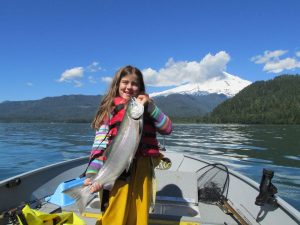
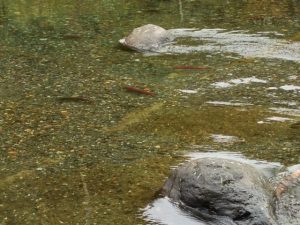
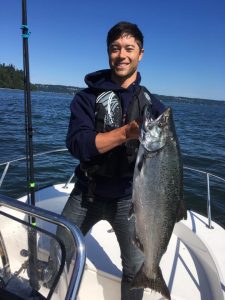
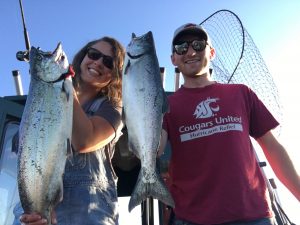
Initially the fish we're planted at Panorama Point and Swift Creek. In an attempt to better distribute the fishery and reduce costs, 3 or 4 years ago they added the Kulshan launch to unload the transport truck. They now use Kulshan, Swift Creek and Panorama Point to unload the transport trucks. The impact on the fishery has been up interesting. While we have caught fish by the dam every year since the fishery opened the use of the Kulshan launch to unload the truck has created a solid fishery at the dam end of the lake. In my opinion the lake conditions; water tempature, flow, lake level play a bigger part in where the fish stage. We have caught fish throughout the lake and in all water depths and in some surprising locations. With changing conditions it seems that high water conditions seem to concentrate fish in a few stock locations, Noisy Creek, Shannon Creek or down by the dam. The fish tend to scatter during lower or changing water levels. I think the key is that independent from water level if your not seeing fish on the meter go look for them. We have caught fish pretty much everywhere on the lake. We have had days where to get out of the crowd we went searching and found limits in from 15-30' of water. Or found fish out in the middle of the lake with nobody around. One day with 4 people on board and only 4 or 5 fish in the box I was running from Shannon Creek back down to Kulshan to pick somebody up. I spotted a school on the meter. We had just passed the little island and I shut down to put a "test line" out. As soon as I got it down to depth, Wham-O we were fish on. I got the rest of the gear down and limited the boat in 45 minutes. Even better, after a stop at Kulshan to go potty, drop people off and pick up a friend I ran back to the area and went 3 for 3 or a quick limit. We had 5 limits by 9:00 in the morning and we were the only boat in the area. The Baker Lake sockeye fishery is a gift from the fish God's. The fishing can be incredible and the scenery stunning. Keep in mind that you don't have to fish the crowds. Enjoy, be safe and good luck. thanks
Hi Mark, do you know if the PUD has always put fish in Baker Lk. down by the dam? Up until last year, my understanding was that all of the fish were trucked to Swift Creek.